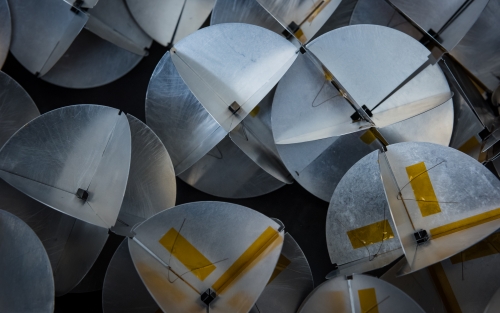“Today’s sophisticated computer models are limited in predicting how the atmosphere will behave in the near or long term and do not provide exact timing of debris reentry,” said Catherine Venturini, a senior project leader in Aerospace’s Science and Technology Strategy and Development department. “We are using inexpensive CubeSats equipped with dosimeters and other unique sensors to conduct experiments that will give us enhanced space situational awareness.”
Most debris models estimate that nearly 1 million debris objects greater than 1 centimeter are in low Earth orbit, of which approximately 30 percent are identified as “lethal debris,” which can damage satellite sensors, erode solar arrays, or possibly puncture a space suit. Improving the space community’s ability to predict a satellite’s mechanical and orbital lifetime, and timing of debris reentry will help maintain a sustainable space environment.
One experiment consists of a dispenser with a set of 28 individually releasable atmospheric probes. These lightweight circular probes, similar in size to CDs, spring open into spherical objects. Due to the probes’ large surface areas being exposed to the atmosphere, they lose altitude quickly and burn up in a matter of weeks. The changes in velocity and altitude due to drag while reentering will be used to measure atmospheric density.

Results from tracking the probes’ reentry also enable improved orbital lifetime calculations, satellite formation flying, and predictions for collision avoidance activities.
Other experiments involve payloads on both AeroCube-10 satellites and deal with measuring radiation that could cause degradation of solar cells in space. Each satellite contains a group of space solar cells with varying levels of radiation-shielding thickness. The experiments provide information on how space solar cells degrade due to charged particle radiation in comparison to the degradation predicted by current models.
Each pair of AeroCube-10 1.5-unit CubeSats measures 10 x 10 x 15 centimeters, and each unit in the pair has virtually identical shapes and mass (within 2 grams), which prevents the units from drifting apart. This proximity allows them to demonstrate satellite-to-satellite pointing and communication and test a steam propulsion thruster aboard AeroCube-10.
About The Aerospace Corporation
The Aerospace Corporation is a leading architect for the nation’s space programs, advancing capabilities that outpace threats to the country’s national security while nurturing innovative technologies to further a new era of space commercialization and exploration. Aerospace’s national workforce of more than 4,800 employees provides objective technical expertise and thought leadership to solve the hardest problems in space and assure mission success for space systems and space vehicles. For more information, visit www.aerospace.org. Follow us on LinkedIn and on X: @AerospaceCorp.
